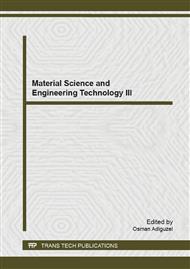[1]
E Ochiai, Bioinorganic Chemistry, John Willey & Sons, New York, p.235, (2008).
Google Scholar
[2]
JB Vincent, (ed), Nutritional Biochemistry of Chromium(III), Elsevier, New York, (2007).
Google Scholar
[3]
KH Thompson, Chiles, J., Yuen VG., Tse, J., McNeill, J.H., Orvig, C., Comparison of anti-hyperglycemic effect among vanadium, molybdenum and other metal maltol complexes, J. Inorg. Biochem 98 ( 2004) 683–690.
DOI: 10.1016/j.jinorgbio.2004.01.006
Google Scholar
[4]
RF Bryan, Greene P.T., Stokely, P.F., Wilson, E.W., J. Inorg. Chem, 10(7)(1971), 1468-1473.
Google Scholar
[5]
W.M. Wallace, Hoggard, P.E., In Search of The Purple Isomer of Tris(glycinato)-Chromium (III), Inorg. Chim. Acta, 65 (1982) L3-L5.
DOI: 10.1016/s0020-1693(00)93475-3
Google Scholar
[6]
Yang XP, Kamalakannan P., Allyn C. Ontkoa, M.N.A. Raoc, Cindy, X.F., Rena,J., Sreejayan,N., A Newly Synthetic Chromium Complex–Chromium(Phenylalanine)3, FEBS Letters 579 (2005) 1458–1464.
DOI: 10.1016/j.febslet.2005.01.049
Google Scholar
[7]
El Shahawi, Chromium (III) Complexes of Naturally Occurring Ligands, Spectrochim. Acta, 51A. (2) (1996)161-170.
Google Scholar
[8]
M Tasner, Prugovecki,B., Mrvos, B., Branka S., Colig,K., Giester G., and Matkovic, D., -Calogovic Synthesis and Crystal Structures of Two Novel Molybdenum (V) Complexes with Glycine and D, L-Valine., Acta Chim. Slov. 55 (2008) 928–934.
Google Scholar
[9]
A Barth, The Infrared Absorption of Amino Acid Side Chains, Progress in Biophysics and Molecular Biology), a review, Progress in Biophysics & Molecular Biology, 74 (2000) 141–173.
DOI: 10.1016/s0079-6107(00)00021-3
Google Scholar
[10]
JH Han, Chi, Y.S. Vibrational and Electronic Spectroscopic Characterizations of Amino Acid-Metal Complexes, J. Korean Soc. Appl. Biol. Chem. 53(6) (2010) 821-825. ).
DOI: 10.3839/jksabc.2010.124
Google Scholar
[11]
M Rasuljan, & Al. Rashid, H., Preparation & Infrared Studies of Hydroxyl Bridged Chromium (III) Complexes of L-Glutamic Acid, J. Chem, Soc. Pak, 11 (1) (1989) 56-67.
Google Scholar
[12]
Aileyabola, IA., Ojo, AC Adebajo, Go., Ogunlusi, Oyetunji,O., Akinkumi E.,O., Adeoye, A.O., Synthesis, Characterization and Antimicrobial Activities of Some metal (II) amino acids' complexes, Advances in Biological Chemistry, 2 (2012) 268-273.
DOI: 10.4236/abc.2012.23034
Google Scholar
[13]
G Vujevic, C Janiak, Structural studies of Bis (cyclopentadienil)molybdenum-amino acid complexes, Z. Anorg. Allg. Chem, 629 (2003) 2585-2590.
DOI: 10.1002/zaac.200300278
Google Scholar
[14]
Cooper, JA., Blackwell L.F., Buckley PD., Chromium (III) complexes and their Relationship to the Glucose Tollerance Factor, Part II: Structure and Biological Activity of Amino Acids Complexes, Inorganica Chimica Acta, 9 (1984) 23-31.
DOI: 10.1016/s0020-1693(00)80060-2
Google Scholar


